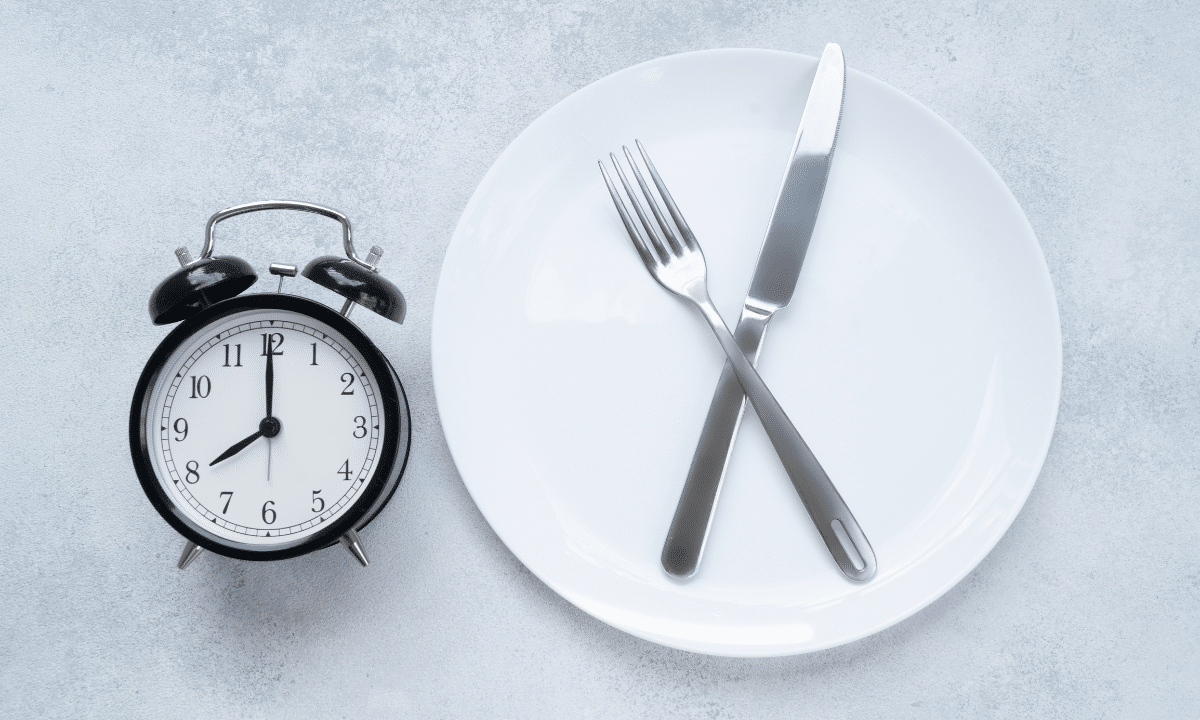Intermittent Fasting for Women Over 40: A Complete Guide
Losing weight after 40 is not easy! Weight loss is a challenge between hormonal changes, changes in body composition, life responsibilities, and life stressors.
Table of Contents
ToggleIntermittent fasting, also known as IF, is a good option for women over 40 who want to lose weight without counting calories or restricting entire food groups. It has very few rules, making it a very straightforward plan.
Because intermittent fasting restricts the amount of time in which you eat, it also makes meal planning more manageable and can decrease the total calories you eat.
Intermittent fasting for women over 40 can work well because it decreases fat without muscle loss, which is a particularly beneficial feature for women in this age group. In addition, this way of eating has several health benefits and can reduce the risk of some common chronic diseases.
There are different types of intermittent fasting, such as the 16:8 and 5:2 plans. Some patterns are easier to follow in the short and long term. This blog will walk you through the different types of intermittent fasting.
What is Intermittent Fasting?
Intermittent fasting, or IF, is an eating style that alternates between periods of fasting and periods of eating. The goal is to abstain from eating for periods of 12 to 24 hours.
It’s important to remember that intermittent fasting is not a diet plan. It only changes your eating habits by limiting when you can eat, not what you can eat.
For example, if you follow the 16:8 IF pattern, you eat all your food for the day during a consecutive 8-hour period, and you fast for the remaining 16 hours. For instance, if your first meal of the day starts at noon, then you will finish your last meal by 8:00 pm.
The intermittent fasting method works because it can naturally cut your calorie intake. But it also prolongs the time in which your body will turn to body fat to use as fuel, making it a good way to lose fat while conserving lean muscle. A study has shown that this healthy weight loss through IF can also increase your levels of the human growth hormone, further encouraging muscle maintenance. (1)
Can Intermittent Fasting Help with Weight Loss?
A number of studies suggest that intermittent fasting can help with weight loss. For example, a 2020 review of 27 studies found weight loss between 0.8% and 13% of the initial weight. (2)
However, more studies are necessary to say with certainty that IF helps with weight loss. More studies are needed to determine how intermittent fasting helps maintain weight loss in the long term.
Other Benefits of Intermittent Fasting for Women Over 40
Intermittent fasting can help control blood glucose in people with type 2 diabetes, a common problem for women over 40. (3, 4)
However, patterns that include fasting every other day, like the alternate-day fasting pattern, can have a negative impact. Studies indicate that fasting every other day might impair the action of the sugar-regulating hormone insulin in both the short term and long term. (5)
If you have diabetes, it’s especially important to consult with a healthcare professional before starting the IF plan. I also recommend fasting for a maximum of 16 hours and to adjust any blood glucose medications according to your eating and fasting hours.
Intermittent fasting can also improve metabolic syndrome, reducing the risk of heart disease and diabetes. (6) The metabolic syndrome refers to a group of symptoms that include high blood pressure, high blood sugar, excess abdominal fat, and abnormal blood fat levels.
Finally, intermittent fasting can also reduce inflammation and boost brain health. (7)
Types of Intermittent Fasting for Women Over 40
| Plan | Overview | Eating window | Fast days per week | Example |
| Time-restricted eating | Eat during a specific amount of time each day | 1 to 8 hours | 7 | 16:8 |
| Alternate-day fasting | Eat one day, fast the next, repeat | Anytime | 3 to 4 | The every other day diet |
| Whole-day fasting | Fast two days a week | Anytime | 2 | 5:2 |
16:8 Intermittent Fasting
In this plan, you fast for 16 hours and eat within an 8-hour window every day.
There’s no set time to fast, but many people skip breakfast and have their last meal around their usual dinner time.
This type of intermittent fasting can be followed by skipping breakfast, having your first meal by 11 am or noon, and finishing your last meal by 7 or 8 pm.
As it naturally follows the eating patterns of traditional American diets, it’s easy to follow, making it very popular. Furthermore, coffee is allowed within the fasting period, so you can still have black coffee in the morning.
However, this pattern is only a suggestion. The 16:8 fasting plan is very flexible, so there are many different eating patterns you can follow within the 24-window to make it fit your schedule, habits, and preferences. The only rule is that it should be the same pattern every day.
Getting Started with the 16:8 Plan

There are no special foods to buy for intermittent fasting and no calories to count; you simply pick your eating time window and stick to it.
If the idea of going 16 hours without food isn’t appealing, you could ease into the plan gradually by incrementally increasing your fasting window. You have a natural fasting window during the hours when you sleep. So at the beginning of this plan, you could simply add more fasting hours before and after your normal sleeping time.
For example, let’s say that you typically eat your first meal at 7 am and your last food by 10 pm, which gives you an eating window of 15 hours and a fasting window of 9 hours (a 9:15 pattern).
During the first week you could stop eating at 8 pm (leaving you with an 11:13 plan). The next week you could skip breakfast and have your first meal at 10:00 a. (a 14:10 plan), and the week after that you have your first meal at 12 noon and finish eating the last at 8 pm.
The idea is to start with shorter fasting periods to make the transition easier.
Tricks to Avoid Feeling Hungry
Surprisingly, fasting can make people feel less hungry as time passes. However, to avoid feeling hungry, the quality of your diet is critical.
For example, sugary and high-carbohydrate foods cause insulin spikes, making you hungry. On the other hand, a diet rich in lean protein, healthy fats, vegetables, fruits, and complex carbohydrates can help you feel satisfied for longer periods because it will have a beneficial impact on the hunger hormones.
Here are some specific tricks to manage hunger:
- Eat a healthy diet throughout the day
- Eat filling foods for dinner: lean protein, healthy fats, vegetables, and foods rich in fiber
- Limit added sugars and high-carbohydrate foods
- Eat plenty of non-starchy vegetables throughout the day
- Drink plenty of fluids
- Drink decaffeinated tea at night
- Pick a routine that keeps your mind off of eating
Whole-Day Fasting: The 5:2 Plan

This plan is a different type of fasting. First, the number refers to days, not hours. So in this plan, you eat for five days and fast for two.
But let’s be clear: a whole day of fasting means very little food not no food. The 5:2 pattern calls for eating about 500 calories for women on each of the fasting days.
Does the 5:2 diet work? Unfortunately, there are very few studies to back up the effectiveness of this type of intermittent fasting. However, there are studies on the 4:3 plan that show promising results.
Getting Started on the 5:2 Plan
It’s pretty simple; this plan’s only requirement is that you consume about 500 calories on 2 days a week. For the rest of the days, you eat without restricting calories. The fasting days don’t need to be consecutive, and they don’t even need to be the same 2 days every week, although it can be useful to identify the same days each week to make it easier to follow.
It’s more sustainable for you to eat two or three days, fast one day, and repeat, making sure that you only fast two days each week.
For your general health and to avoid cravings, it’s a good idea to eat a well-balanced diet consisting of vegetables, fruits, lean proteins, healthy fats, and whole grains while avoiding sugars, high-carbohydrate meals, junk food, and excessive amounts of food during the eating days. For successful weight loss, it’s essential that you don’t overcompensate for the fasting days by overeating on the other days. In order to lose weight, you will need to eat fewer calories throughout the week overall.
You might choose to eat 2-3 meals consisting of very low-calorie foods on the days that you fast, adding up to no more than 500 calories combined. If you avoid doing two consecutive days of fasting, it can make it easier to stick to the plan.
Food and Meal Ideas for the 5:2 Diet
- Non-starchy vegetables such as leafy greens, lettuce, arugula, mushrooms, peppers, and onions. Avoid potatoes, malanga, yuca, butternut squash, sweet potato, corn, and anything else with starch.
- Plain Greek yogurt and berries.
- Hard-boiled eggs.
- Small amounts of lean protein.
- Broths.
- Coffee, tea, water.
It’s astonishing how easy it is to eat only 500 calories! Here are some meal plans for your fasting days:
A Dietitian’s Opinion on the 5:2 Plan
In my professional and personal opinion, this type of intermittent fasting could be challenging to maintain in practical terms as it involves a lot more planning than other types of IF.
You will need to consider how you feel about the fasting days and how well you can control your intake during the non-fasting days so that you don’t overeat. Also, you should be aware that certain medical conditions can potentially make this plan unsafe.
Whole-Day Fasting: The 4:3 Plan
This plan is very similar to the 5:2 plan, but you eat four instead of eating five days of the week. Identical to the 5:2 program, in the 4:3 plan, you eat 500 calories during the fasting days.
This plan is very similar to the 5:2 plan, but you eat for four days of the week instead of five. Identical to the 5:2 program, in the 4:3 diet, you eat 500 calories during the fasting days.
Benefits of the 4:3 Plan (8, 9)
- Improves insulin resistance
- Potential to reduce hot flushes
- Reduces markers of oxidative stress
- Decreases markers of inflammation (which can help with the prevention and treatment of many chronic diseases)
- Reduces body weight
- Decreases fat mass without change in muscle mass
- Lowers levels of leptin, a hormone related to weight management
- Reduces stress belly
Food and Meal Ideas for the 4:3 Diet
- Non-starchy vegetables such as lettuce, arugula, mushrooms, peppers, and onions. Avoid potatoes, malanga, yuca, butternut squash, sweet potato, corn, and anything else with starch.
- Plain Greek yogurt and berries.
- Hard-boiled eggs.
- Small amounts of lean protein.
- Broths.
- Coffee, tea, water.
- Meal ideas
Alternate-Day Fasting
This type of intermittent fasting is also known as the every other day fasting diet because, as the name suggests, it alternates between a day of fasting and a day of eating.
As with the other plans, on the fasting days you can consume up to 500 calories.
Some studies suggest that alternate-day fasting can help decrease obesity, markers of inflammation, heart disease and diabetes, and improve pulmonary function (10). However, research shows that the plan is not superior to traditional caloric restriction. (11)
Possible Side Effects of Intermittent Fasting
In some studies, a small proportion of people who followed intermittent fasting reported the following side effects: (12)
- Hunger and cravings
- Headaches and light-headedness
- Nausea, diarrhea, bloating
- Dehydration
- Irritability and other mood swings
- Fatigue
- Lower energy levels
- Weakness
- Low blood sugar
- Difficulty sleeping
- Malnutrition
Before You Begin Intermittent Fasting
Before you start intermittent fasting, you need to determine if the plan is suitable and safe for you.
If you are diabetic on medication designed to lower your blood sugar, the medicines need to be adjusted to match your eating schedule. As a doctor in clinical nutrition, I would recommend avoiding whole-day fasting plans and talking to your medical doctor to adjust your medication to match your eating and fasting times.
In addition, speak to your health care provider if you are taking medications that must be taken with food.
Finally, the plan might not be suitable for you if:
- You regularly experience low blood sugar
- You are underweight
- You have an eating disorder
- You are immunocompromised
Seek medical advice if you have any doubts about whether this plan is healthy for you.
The Bottom Line
Intermittent fasting for women over 40 is an easy and effective way to lose weight, and it also has potential health benefits. So, it’s not a surprise that intermittent fasting has become a very popular method for losing weight and maintaining the loss.
In my professional opinion, the 16:8 is more sustainable and easier to follow. It works because it’s flexible, intuitive, inexpensive, and sustainable.
To explore other diet options, check out our other blog posts:

Dr. Su-Nui Escobar, a Registered Dietitian/Nutritionist in Miami, FL, is dedicated to empowering women in perimenopause and menopause to live healthier, more satisfying lives.
With a doctorate in clinical nutrition from the University of North Florida, she has expertise in menopause and weight loss, including the unique challenges faced by those on weight loss medications.
Su-Nui’s passion for her field is evident in her previous role as the Academy of Nutrition and Dietetics spokesperson.



1 thought on “Intermittent Fasting for Women Over 40: A Complete Guide”
All the recommendations in this article are very good for those of us who are looking for a practical and effective solution for weight loss, thank you for sharing all these tips. It is hard to get such accurate information. Since other sites I have visited in the past do not offer such useful information.